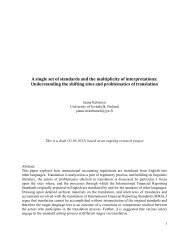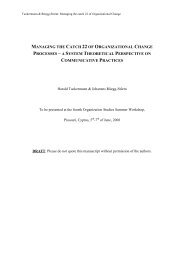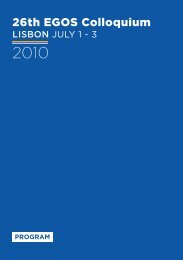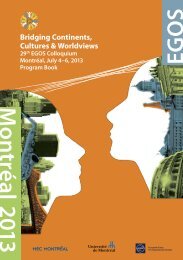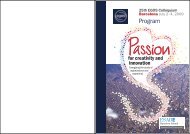Download Full Paper - EGOS
Download Full Paper - EGOS
Download Full Paper - EGOS
You also want an ePaper? Increase the reach of your titles
YUMPU automatically turns print PDFs into web optimized ePapers that Google loves.
attention to the phenomenon of standard-use mediators and their metastructuring activities in<br />
mastering the multiplicity and plurality of standards. The following section will deliver the<br />
theoretical background on standard-use mediation. Section 3 describes the research design.<br />
The findings of our case study “A-Suppliers” are presented in section 4. The paper will be<br />
completed by the discussion and conclusion and will deliver insights about the process of<br />
metastructuring as a powerful mechanism in dealing with multiple and plural standard<br />
requirements in organizations.<br />
2. Theory<br />
With this paper we report on a specific type of structuring activities around standards within<br />
organizations. We do not describe the influences standards can have, for instance, on learning<br />
or innovating (Fried 2010, Fried et al. 2011, Gey 2011) or other activities where standards can<br />
have an important influence. Rather, we focus on a process Orlikowski et al. (1995) called<br />
metastructuring. Metastructuring was primarily used in the context of technology research.<br />
Yates et al. (1999) found out that “a few members of the project group explicitly engaged in<br />
activities that facilitated both early and ongoing use of the new technology by the rest of the<br />
project group” (Yates et al. 1999, p.84f.; see also Okamura et al. 1994, Orlikowski et al.<br />
1995). These activities included guidelines for the use of the new (conference) technology,<br />
providing qualification and follow-ups in using the technology as well as modifying it<br />
according to contextual, project-specific requirements. Orlikowski et al. (1995) summarized<br />
metastructuring “as an organizational mechanism for facilitating the ongoing adaptation of<br />
technologies, their use, and organizational contexts to each other and to changing<br />
conditions”.<br />
Further, Orlikowski et al. (1995) classified four types of metastructuring activities:<br />
establishment, reinforcement, adjustment and episodic change. During establishment the<br />
mediators establish their roles in the organization, they set up the infrastructure and<br />
implement the new technology. They also need to promote and support the new technology,<br />
<strong>Full</strong> paper GEY & FRIED <strong>EGOS</strong> conference 2012, Sub-theme 15 3





